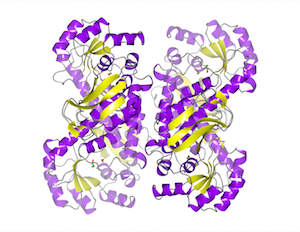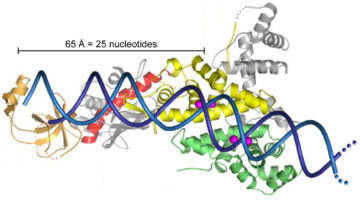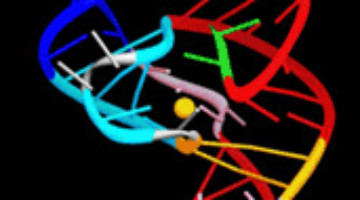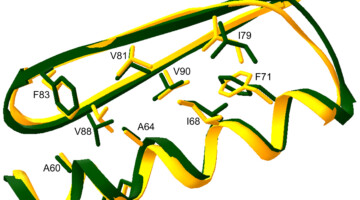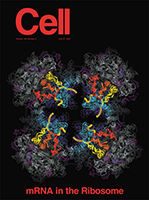The Berkeley Center for Structural Biology’s Collaborative Crystallography (CC) program is making major advancements in solving protein structures, especially for users involved in high-throughput projects. The CC program is an NIH-funded, peer-reviewed service that allows external users to apply for both beam time and the support of a crystallographer to perform experiments and subsequent data analyses. Read more »
ALS Work Using Protein Crystallography
Protein crystallography is used for determining the molecular structure of proteins. Crystallized protein molecules cause a beam of incident x-rays to scatter in many directions, with constructive and destructive interference generating a diffraction pattern. By analyzing these patterns, a crystallographer can produce a three-dimensional picture of the density of electrons within the crystal and thus determine the protein's structure.
First Detailed Look at RNA Dicer
Scientists have gotten their first detailed look at the molecular structure of an enzyme that Nature has been using for eons to help silence unwanted genetic messages: Dicer, an enzyme that plays a critical role in a process known as RNA interference.
Read more »![]()
![]()
Snapshots of Ribozyme Reaction States Reveal Structural Switch
RNA, like protein, can sometimes function as an enzyme (ribozyme) to speed biochemical reaction rates. But how does RNA, a simple polymer, enhance reaction rates by at least a million fold? Researchers obtained the structures of a ribozyme trapped in different states of its catalytic cycle, showing how a change in the RNA conformation governs the reaction mechanism. Read more »![]()
![]()
Designing a Novel Globular Protein Fold
A major challenge of computational structural biology has been to create, from scratch, new proteins with heretofore unobserved three-dimensional structures. Researchers have now developed and demonstrated a methodology for protein-structure prediction and design by creating the first artificial globular protein with a novel topology. Significantly, the x-ray structure agreed almost precisely with the structure specified by the computational model. Read more »![]()
![]()
The Path of Messenger RNA through the Ribosome
Using x-ray crystallography, researchers directly observed the path of mRNA in the 70S ribosome in Fourier difference maps at 7 Å resolution. Image depicts the view down the crystallographic 4-fold axis of the 70S ribosome-mRNA-tRNA complex, showing the head-to-tail juxtaposition of the model mRNAs (red-orange) between adjacent ribosomes. Read more »
- « Previous Page
- 1
- …
- 13
- 14
- 15
